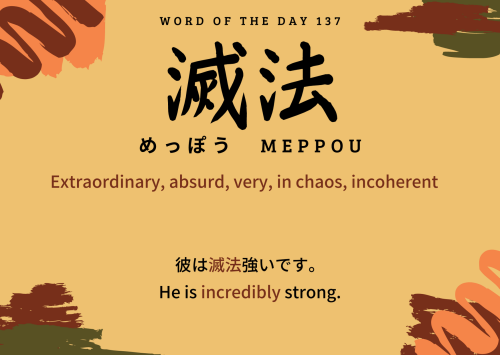#n3 kanji
JLPT Level: Unlisted, but the kanji are N1 and N3 respectively.
Alright, this is a pretty interesting word that’s seen some changes in meaning and usage over the centuries.
滅
- On-yomi: metsu
- Kun-yomi: horo.biru, horo.bu, horo,bosu
- Meaning: destroy, ruin, overthrow, perish
法
- On-yomi: hou, ha, ho, furan
- Kun-yomi: nori
- Meaning: method, law, rule, principle, model, system
If we put the two together, we get “The Law of Destruction,” which could be a pretty rad metal song.
Originally, this was a Buddhist term used to refer to…something too hard for me to wrap my pea brain around haha. Really trying to remember everything I learned in that one Buddhist Philosophy course I took in uni back in the day.
Okay okay. Basically, all things in existence are divided into two categories:
- Conditioned existence (a.k.a. things created by fate). This is known as saṃskṛta in Sanskrit.
- Those that have transcended conditioned existence. This is known as asaṃskṛta in Sanskrit.
Meppou is the old Japanese Buddhist term for “things that have transcended conditioned existence.” This can mean that a thing has reached Nirvana, something that is “absolute.”
From that meaning, meppou came to mean something “extraordinary” or “terrible and intense” like a historic typhoon.
Most of the time, meppou is used in the phrase 滅法強い meppou tsuyoi, “terribly powerful.”
Post link
JLPT Level: Unlisted, but the kanji are N4 and N3 respectively.
While not a super common word, you do have a chance of hearing it in conversation once in a blue moon. It’s also incredibly easy to understand once you know the parts.
言い ii, to say
伝え tsutae, to communicate, transmit
So 言い伝え is something that is spoken and transferred from one generation to the next.
Post link
JLPT Level: N1, and the kanji are N3 and N2 respectively.
Wow, two words that are on the JLPT in a row. Am I losing my edge?
Let’s break down the kanji:
到
On-yomi: tou
Kun-yomi: ita.ru
Meaning: arrival, proceed, reach, attain, result in
底
On-yomi: tei
Kun-yomi: soko
Meaning:bottom, sole, depth, bottom price, base, kind, sort
So we can put these two kanji together to get the literal meaning of “reaching the bottom.” How does that come to mean “cannot possibly,” or “no matter how”?
Well, I did some expert googling but was unable to find anything. :(
My personal opinion, though, is that it’s either of two things:
- “I am certain to the bottom of my heart that this is impossible.”
- Even if you reach down within yourself and do your best, it is impossible.”
Those are just guesses, and I’m not a native speaker, but that’s my take.
Post link



